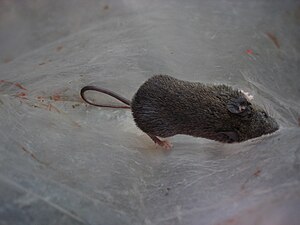Sikkim mouse
| Sikkim mouse | ||||||||||||
|---|---|---|---|---|---|---|---|---|---|---|---|---|

Sikkim mouse ( Mus pahari ) |
||||||||||||
| Systematics | ||||||||||||
|
||||||||||||
| Scientific name | ||||||||||||
| Mus pahari | ||||||||||||
| Thomas , 1916 |
The Sikkim mouse ( Mus pahari ) is a species of the mice (genus Mus ) that occurs in South and Southeast Asia from northeast India and Nepal via Myanmar and the southern People's Republic of China to Thailand , Laos , Cambodia and Vietnam .
features
The Sikkim mouse reaches a head-torso length of 8.8 to 10.3 centimeters and has a tail that is about the same length, often slightly longer (8.8 to 9.0 centimeters). The weight varies from 21 to 24 grams. The rear foot length is 21 to 23 millimeters, the ear length 15 to 17 millimeters. The habitus resembles a shrew with a long nose, small eyes and short ears. The back fur is dark blue-gray, spiky in adult animals. The ventral side is silver gray. The tail is two-colored on top, dark brown and white on the underside. The top of the hands and feet is white.
The skull has a total length of 24 to 26 millimeters. It is much more curved than in other species of the genus.
distribution
The Sikkim mouse occurs from northeast India and Nepal via Myanmar and the southern People's Republic of China to Thailand , Laos , Cambodia and Vietnam . In China, she lives in the southeast of Xizang , in Yunnan , the south of Sichuan, as well as in Guizhou and Guangxi . In India, the species occurs in the states of Arunachal Pradesh , Assam , Meghalaya , Mizoram , Nagaland , Sikkim and in West Bengal . The altitude distribution ranges from 200 to about 2000 meters.
Way of life
Little data is available on the way of life of the Sikkim mouse. The animals live in forests at high altitudes. They are nocturnal and live terrestrially and semi-arboreally. They feed on insects and build round nests out of dry grass, but do not dig in the ground.
Systematics
The Sikkim mouse is classified as an independent species within the genus of mice ( Mus ), which consists of around 40 species. The first scientific description comes from Oldfield Thomas from 1916, who described the species using individuals from the Indian state of Sikkim from an altitude of 1,830 meters.
Smith & Yan Xie 2009 describe three subspecies for China: Mp gairdneri in Yunnan, Mp pahari in Xizang and Mp jacksoniae in the rest of the distribution area.
Status, threat and protection
The Sikkim mouse is classified as Least Concern by the International Union for Conservation of Nature and Natural Resources (IUCN). This is justified by the very large distribution area and the frequent occurrence of the species, partly also in protected areas, as well as their adaptability to habitat changes. There are no potential threats to the existence of this species.
supporting documents
- ↑ a b c d e Andrew T. Smith, Darrin Lunde: Indochinese Shrewlike Mouse. In: Andrew T. Smith , Yan Xie: A Guide to the Mammals of China. Princeton University Press, Princeton NJ 2008, ISBN 978-0-691-09984-2 , p. 264.
- ↑ a b c d e f Mus pahari in the IUCN Red List of Threatened Species 2014.3. Posted by: K. Aplin, D. Lunde, S. Molur, 2008. Retrieved July 4, 2015.
- ↑ Mus pahari ( Memento of the original from July 5, 2015 in the Internet Archive ) Info: The archive link was inserted automatically and has not yet been checked. Please check the original and archive link according to the instructions and then remove this notice. . In: Don E. Wilson , DeeAnn M. Reeder (Eds.): Mammal Species of the World. A taxonomic and geographic Reference. 2 volumes. 3. Edition. Johns Hopkins University Press, Baltimore MD 2005, ISBN 0-8018-8221-4 .
literature
- Andrew T. Smith, Darrin Lunde: Indochinese Shrewlike Mouse. In: Andrew T. Smith , Yan Xie: A Guide to the Mammals of China. Princeton University Press, Princeton NJ 2008, ISBN 978-0-691-09984-2 , p. 264.
Web links
- Mus pahari inthe IUCN Red List of Threatened Species 2014.3. Posted by: K. Aplin, D. Lunde, S. Molur, 2008. Retrieved July 4, 2015.